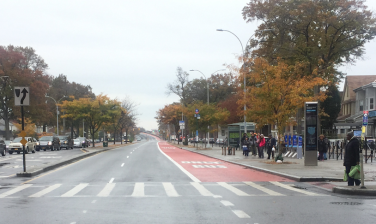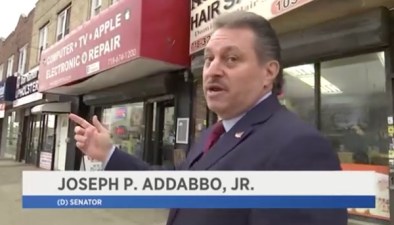Queens Residents Speak Up for Bus Rapid Transit on Woodhaven

Woodhaven Boulevard is one of the city’s most dangerous roads — eight pedestrians were killed there from 2010 to 2012, more than any other street in Queens. And while bus riders make 30,000 trips on Woodhaven each day, they’re slowed down by congestion and awkwardly designed service roads.
The MTA and DOT are working on a redesign that could dramatically improve both problems by dedicating more space to walking and transit. As the plans are developed and the agencies present the project to the public, residents say there’s a disconnect between who’s speaking the loudest at community meetings and who would benefit from the potential improvements. There are people who support major changes along the Woodhaven corridor, but their perspectives aren’t coming through in the local media coverage.
Toby Sheppard Bloch and his wife, a Queens native, have lived in Glendale near the busy intersection of Woodhaven and Metropolitan Avenue for almost 10 years. They have a 5-year-old daughter. “I drive a bunch. I’m a general contractor, so I’m often behind the wheel,” he said. “Even as a driver, it’s a nerve-wracking road to drive down. There’s a lot of speeding, and it’s very crowded.”
Sheppard Bloch has seen many serious crashes on Woodhaven, and the danger spills over as impatient drivers use local streets as shortcuts. He’s worried about his daughter, who will soon be walking around the neighborhood to meet with friends. He and his wife often take the bus or their bikes to catch the subway at Queens Boulevard. The buses are often overcrowded and slow, he says.
The redesign needs to make a clean break with the status quo, he said. “We’ve committed as much space as we possibly can on Woodhaven to cars,” Sheppard Bloch said. “It’s broken. We need to think about a different approach.”
He’s attended meetings organized by the MTA and DOT, and he hopes they pursue physically-separated bus lanes running down the middle of Woodhaven and Cross Bay Boulevards. “I see a separated center lane as a real solution to all those problems,” he said. “I can almost walk it faster than I can take the bus during rush hours.”

Stephanie Khan understands the frustration. She lives in Ozone Park near Woodhaven and 101st Avenue and works as a registered nurse at NYU-Langone Medical Center. She used to drive often, but an ankle injury has her on the bus more often now. At work, she sees people recovering after getting hit by drivers “all the time” and thinks a center-running bus lane would help make Woodhaven safer, so people don’t have to dash across the entire width of the road to catch a bus coming in the other direction. “I don’t see it as taking lanes away from the road. I see it as an improvement,” she said of BRT. “Safety is my number one concern.”
Emily December, a Queens College senior who lives near Woodhaven and Atlantic Avenue, is canvassing Woodhaven and Cross Bay Boulevard for the Riders Alliance this summer, talking to riders about bus rapid transit and asking if they’d like to sign on in support.
“There’s so many people that don’t understand or don’t know about bus rapid transit, so I try to educate,” she said. “They like the fact that you can pay before you board, and that it can turn the lights from red to green, and the designated bus lanes.”
“I’ve noticed as the years go by that more and more people are taking buses on Woodhaven Boulevard, especially at night,” she said. Buses don’t run as often then, and many of them are overcrowded. “There’s a lot of young women coming home from work at the [Queens Center] Mall,” she said.
December went to a meeting the Riders Alliance organized last month about Woodhaven, and noticed differences between who came out for the event and who signed her petition. “Most people that sign the petition don’t make it to the meeting, and I can understand why,” she said. “Because at the time the meeting occurs, they’re commuting home.”
Sheppard Bloch said two groups — people who live or own a business directly on Woodhaven and community board members — formed the majority of people at public meetings hosted by the MTA and DOT where concerns about parking and removing car lanes took up a lot of oxygen. “The issues that are discussed are issues about the primacy of the car,” he said. “I don’t see why one person in one car should be entitled to inconvenience hundreds of people trying to commute back and forth from work.”
“The only time I heard about parking issues is when I went to the forums,” December said. “I never really hear about parking concerns, because the majority of people I talk to are bus riders.”
Sheppard Bloch said he hopes the planners hear from more than just the people who show up to meetings, and suggested an online map as one way for people to offer their input if they can’t make it to the forums.
The first phase of the project, set for implementation this year, would feature curbside bus lanes for a few blocks near Liberty Avenue and offset bus lanes for 1.4 miles between Eliot and Metropolitan Avenues [PDF]. A larger plan for a more robust BRT route is anticipated this fall.
In the meantime, bus riders continue to put up with crowded, unreliable service along one of the most dangerous streets in Queens. December occasionally takes the bus home at night from the Rockaways. “By the time I hit 153rd Avenue and Cross Bay, by the Waldbaum’s, the bus is full,” she said. “That’s the reality.”



